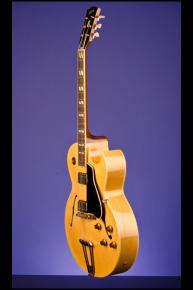A Very Beautiful 1959 Blonde ES-175DN… BUT…
1959 Gibson ES-175DN.
This 16 1/4-inch-wide, 3 3/8 inches deep guitar weighs just 6.50 lbs. and has a three-ply laminated maple body. One-piece Honduras mahogany neck with a nice fat nut width of just over 1 11/16 inches, a standard Gibson scale length of 24 3/4 inches and a wonderful and typical '59 thick profile, and rosewood fretboard with 20 original jumbo frets and inlaid pearl split-parallelogram position markers. Headstock with inlaid pearl "Gibson" logo and pearl crown inlay. Reproduction two-layer, black over white plastic truss-rod cover secured by two screws. The body of the guitar is triple-bound on the top and single-bound on the back. Inside the bass f-hole is an orange label with the style "ES-175 DN" written in black ink and the serial number "A 29781" stamped in black. (Reproduction) individual single-line Kluson Deluxe tuners with single-ring Keystone plastic buttons. Two Gibson '57 Classic humbucker pickups with black rectangular labels underneath and outputs of 7.57k and 7.08k. Reproduction five-layer (black over white) plastic pickguard. Four controls (two volume, two tone) on lower treble bout plus three-way selector switch on upper bass bout. Reproduction gold plastic bell-shaped knobs. Reproduction ABR-1 bridge with on rosewood base and reproduction trapeze tailpiece with pointed ends and three small raised parallelograms. Housed in an original (very worn) fifties four-latch, shaped brown hardshell case with padded green felt lining (7.50).
This guitar (1 of just 129 ES-175DNs shipped in 1959) suffered some damage in shipping (a break at the heel and a split on the bass side) and was 'stripped' of all the original electrics and hardware including a pair of double-white PAFs. We sent the guitar to our luthier and he has miraculously restored the body to its former glory and fitted it with the best quality reproduction parts including a pair of Gibson '57 Classic humbucker pickups. The incredible repair work to the neck heel and body side is totally invisible to the naked eye and the guitar plays and feels just like a '59 should. This is a great opportunity to have a real vintage blond ES-175 which you can actually use on stage. She sounds really good too.
Although the ES-175 was originally introduced in August 1949 (so-called because it initially retailed at $175.00), it only had a single P-90 pickup, and it was not until 1953 that the two pickup version with four controls and a three-way toggle switch was introduced. So successful was this configuration, that Gibson went on to adopt this arrangement for most of its twin pickup guitars.
"At the time the ES-295 was introduced in 1952, the ES-175 was available only as a single pickup model even though a very few models had been custom-ordered with two pickups since its inception in 1949. But it did not take long to realize that a 175 with two pickups would be a neat proposal to consolidate the lower end of the electric range. In early 1953, a 295 was thus converted into a two-pickup 175 and by April the first production ES-175D (D stands for dual pickups) were shipped from the factory. Ted McCarty and Clarence Havenga probably did not fully appreciate it at the time but one of the all-time Gibson classics was born. The affordable 175 and 175D proved immensely popular during the 50s and became the workhorse of many fine jazz guitarists such as Kenny BURRELL, Jim HALL or Herb ELLIS to name just a few" (A.R. Duchossoir, Gibson Electrics -- The Classic Years, p. 55).
"The ES175 is Gibson's most successful electro-acoustic guitar. An estimated 37,000 were sold between 1949 and 1990 and it continues to sell in healthy numbers, despite unprecedented Japanese competition. Dozens of look-alikes and near copies provide testimony to the instrument's dependability, tonal responsiveness and aesthetic quality. From the hundreds of electric guitars which have come and gone over the last fifty years, only a handful have survived with little deviation from their original form...Steve Howe, King Sunny Ade, B.B. King, Mel Brown and Derek Bailey have used the 175 to good effect in other genres. However, it is jazz guitarists who have been seen using the 175 consistently for more than four decades and it is they who provide the instrument's strongest cultural association. Forty [now fifty] years of record sleeves, magazine articles, TV appearances and gigs by eminent jazz guitarists have established the 175 as the pre-eminent jazz guitar. The shape, design and construction of the 175 have changed little in more than forty [now fifty] years of continuous production, affirming its tradition of dependability whilst reaffirming its status as a design classic" (Adrian Ingram, The Gibson ES175: Its History and Players, p. xi).

















